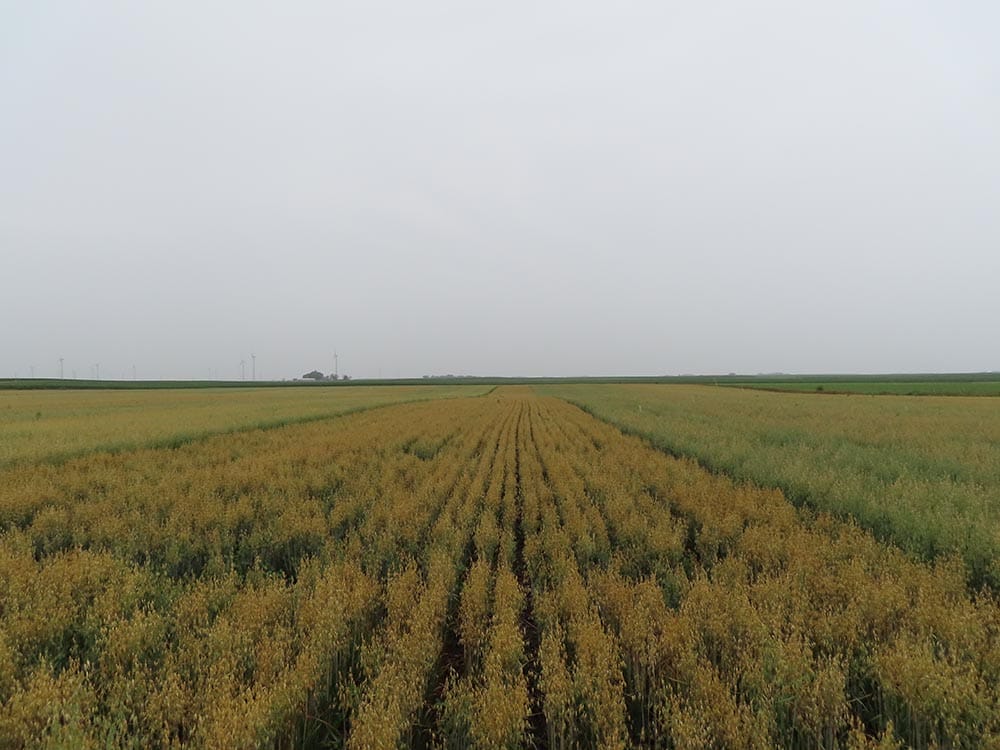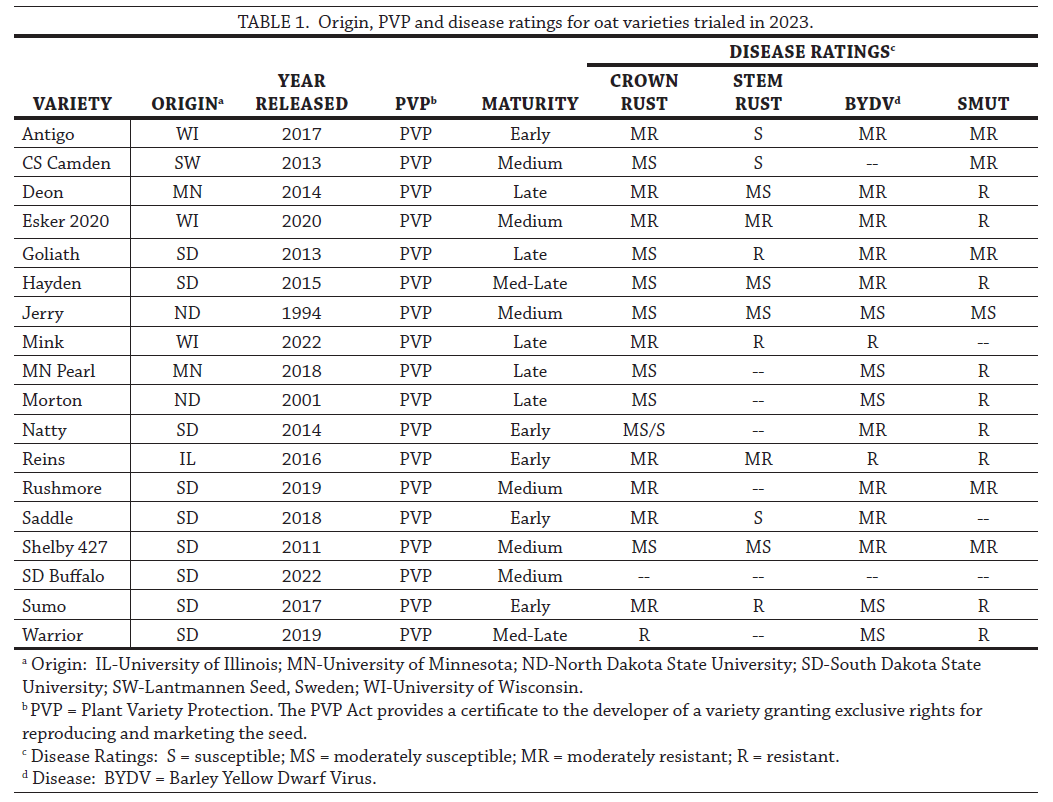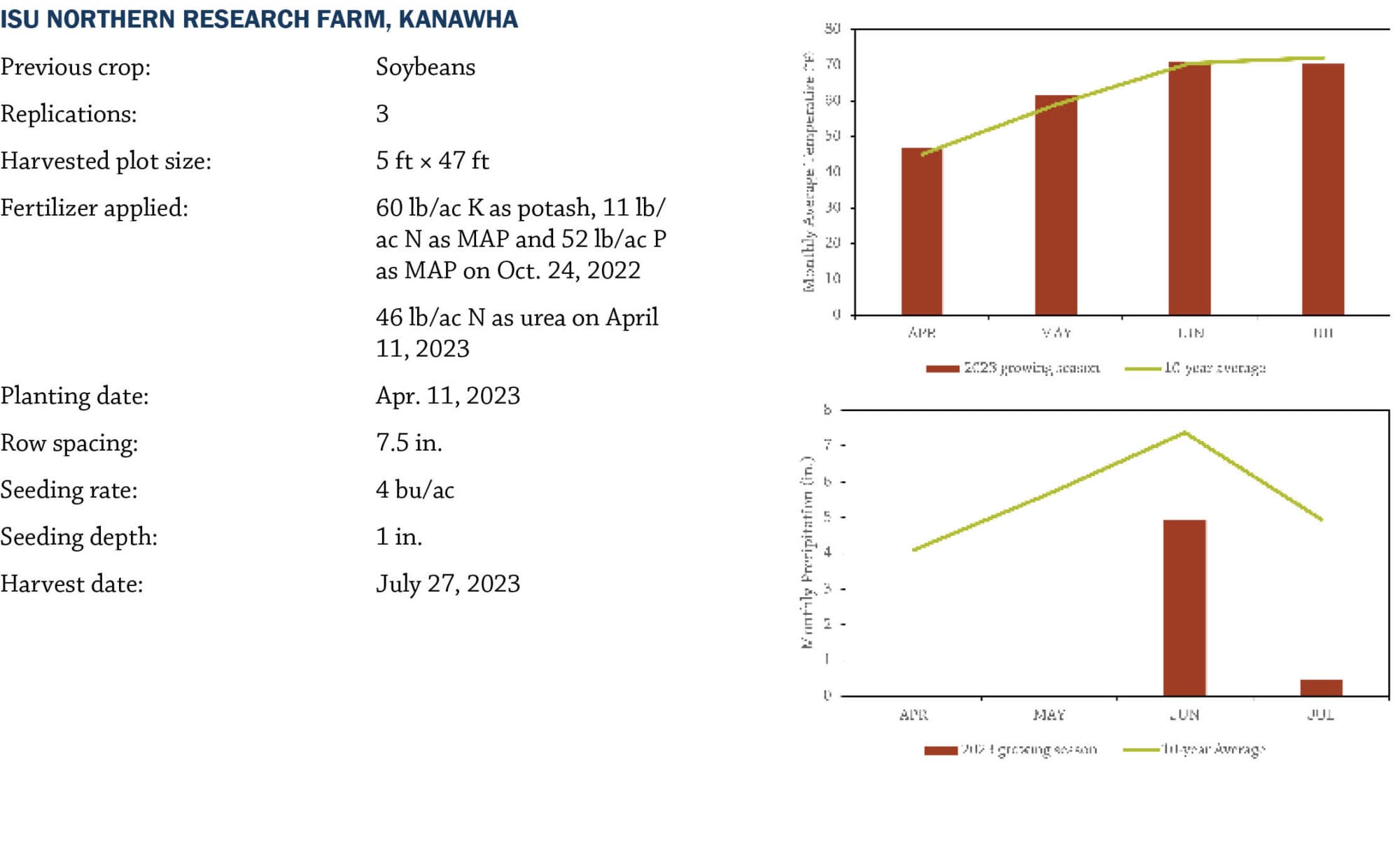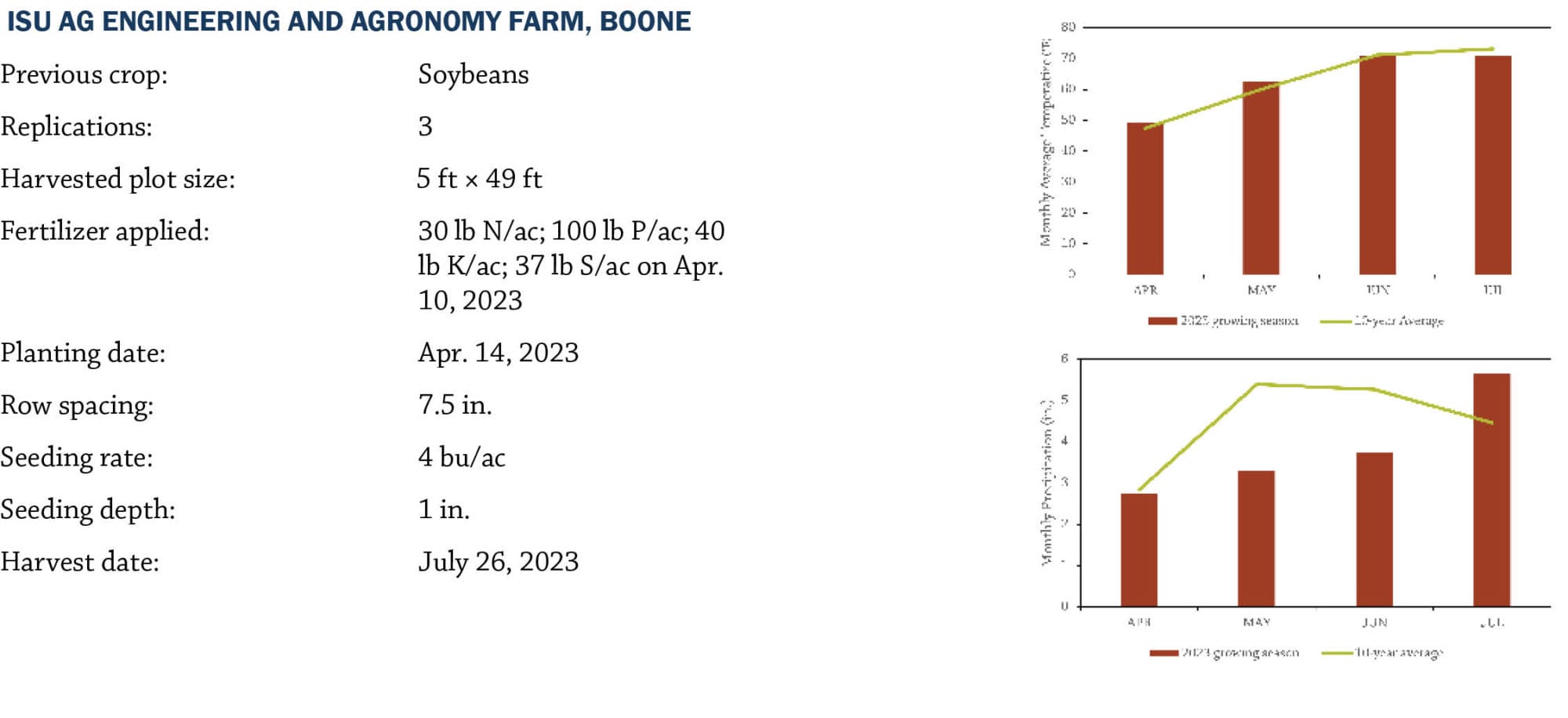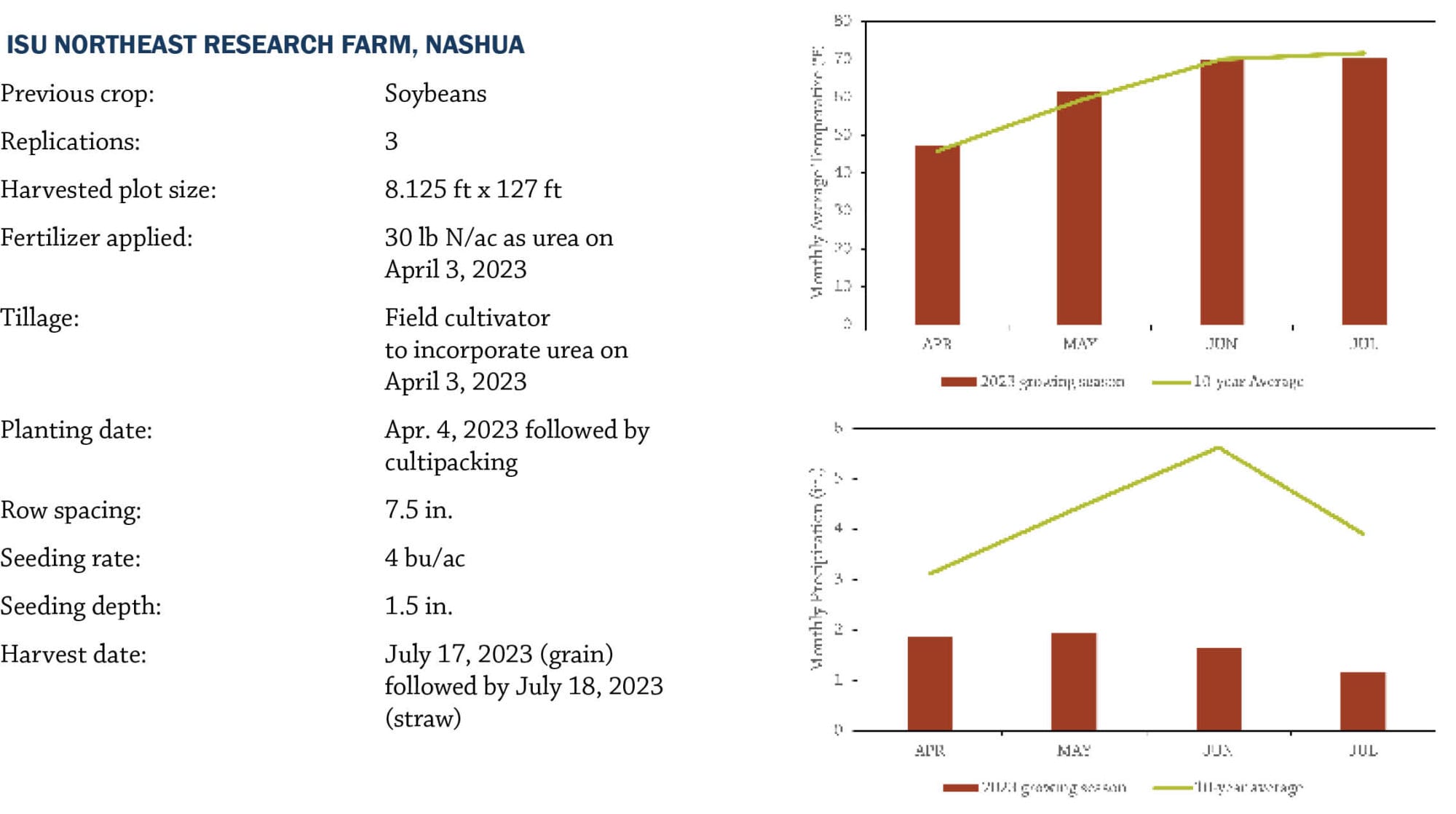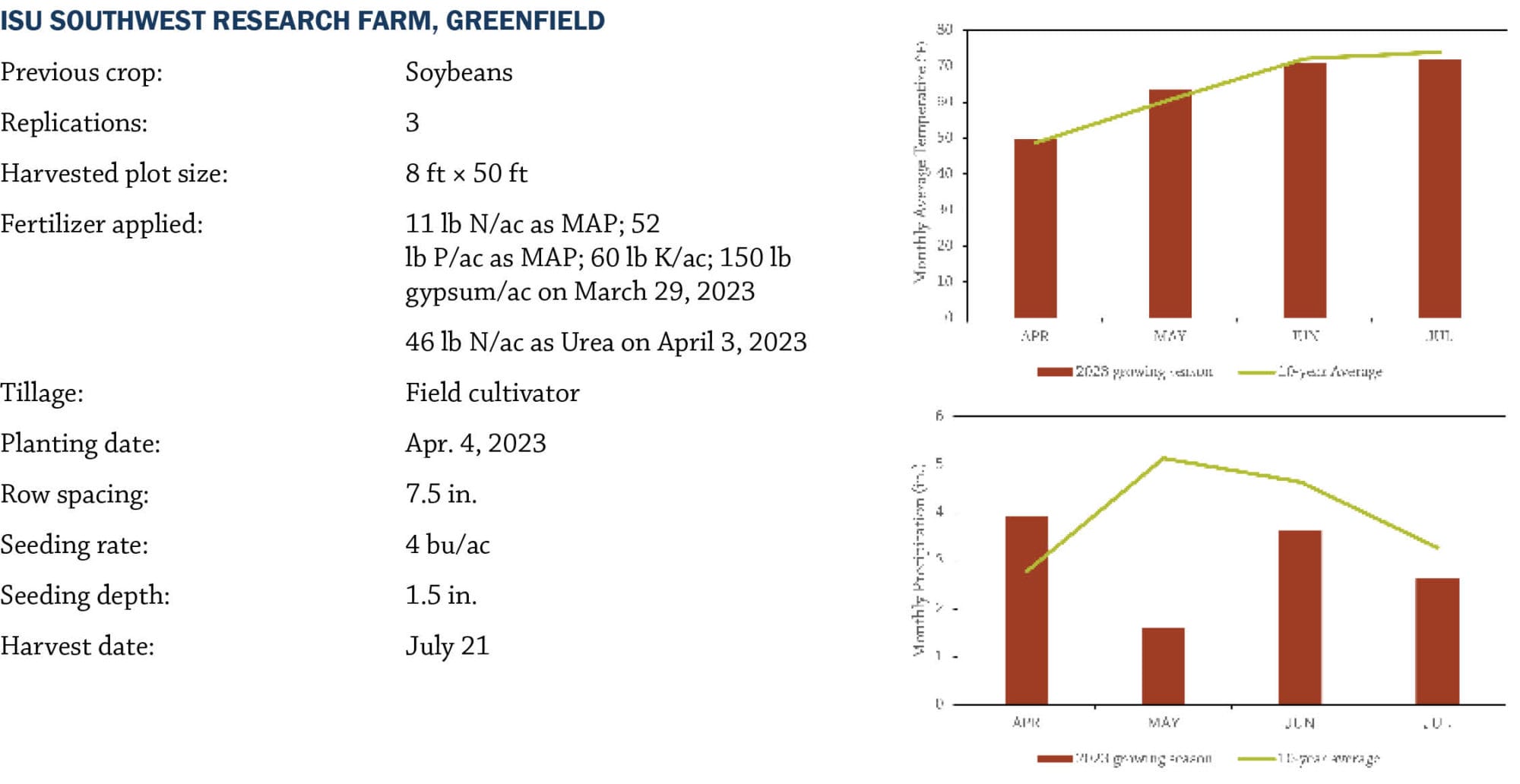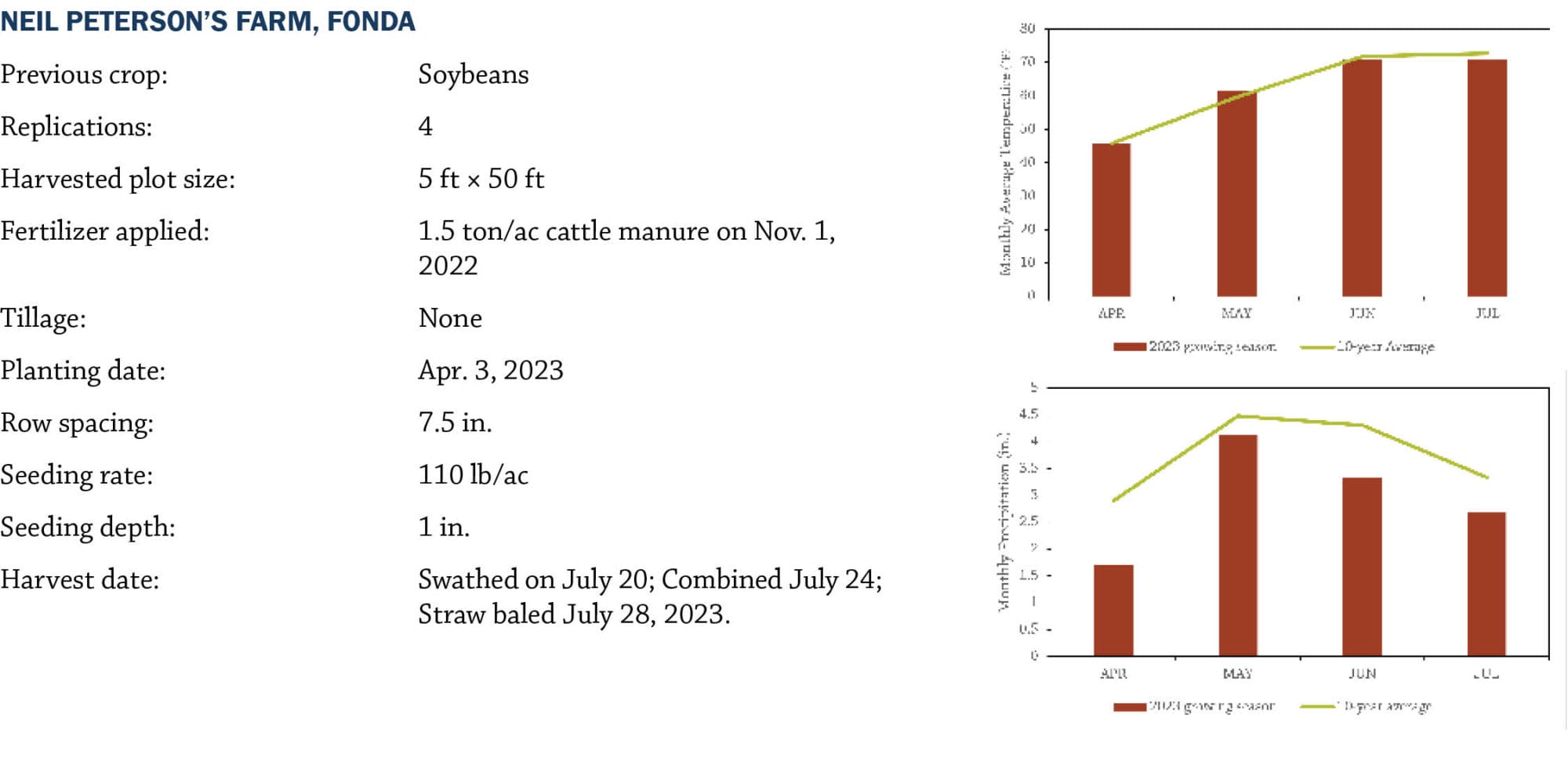This research was funded by USDA-NIFA, Walton Family Foundation, Albert Lea Seed House, Green Cover, Welter Seed and Honey Co., SDSU Seed Foundation, UW Foundation Seeds and Zabel Seeds.
In a Nutshell
- 16 oat varieties were screened at four Iowa State University research farms and four oat varieties were trialed by Neil Peterson on his commercial farm.
Key Findings
- Across varieties and sites, average oat yield was 130 bu/ac and average test weight was 36 lb/bu.
- Antigo was the only variety to score a test weight ≥ 38 lb/bu (food grade) at each location where it was trialed. Reins, Rushmore, Shelby 427 and Sumo also scored test weights ≥38 lb/bu at Kanawha.
Background
In 2023, 200,000 acres of oats were planted in Iowa according to the USDA-National Agricultural Statistics Service; up from 130,000 acres in 2022 and 180,000 acres in 2021. The state average yield for the year was 80 bu/ac; the five-year average yield is 74.6 bu/ac [1]. Oat grain and straw yield and attributes like lodging propensity can vary by variety and growing conditions. This means that oat variety trials at sites across the state are important tools for farmers who grow oats. Since 2015, PFI has helped organize oat and other small grains variety trials at Iowa State research extension offices around the state, and four sites participated this year. A commercial farmer, Neil Peterson, also joined the variety trial this year and tested four oat varieties on his farm. At the beginning of the trial, Peterson reported that “I would like to figure out which oat varieties best fit my farm and my goals for growing oats. I also hope that the variety trial would give me some experience in conducting a more official trial and provide something of interest that I could show to visitors to our farm.”
Methods
Variety trials were conducted at five locations in 2023: ISU Northern Research Farm in Kanawha; ISU Ag Engineering and Agronomy Farm in Boone; ISU Northeast Research Farm in Nashua; ISU Southwest Research Farm in Greenfield; Neil Peterson’s farm near Fonda in northwest Iowa. These variety trials build on previous trials conducted at Kanawha, Charles City, Boone, Nashua and Greenfield from 2015–2022 [2]–[9]. Information about each of the varieties trialed in 2023 can be found in Table 1.
Oat management information is provided with the results from each location. No herbicides or insecticides were applied at any location during the oat growing season. Statistical significance is determined at 90% confidence level and means separations are reported using Tukey’s least significant difference (LSD). Data were analyzed by location, and varieties are listed in alphabetical order at each location. Reported yields are corrected for 13% moisture. Rainfall and temperature data were accessed from the nearest weather station [10].
Results and Discussion
Rainfall in 2023 was generally at or below 10-year averages at all sites during all months of the oat growing season. At the time of oat harvest, all sites were impacted by abnormally dry to severe drought according to the U.S. Drought Monitor [11].
Yields at Boone, Greenfield and Kanawha were generally higher in 2023 than the 4 or 8-year yield averages from these sites (Tables 2-5). Yields at Nashua were similar to the 8-year average for each variety. Across sites, four oat varieties were significantly higher yielding; Rushmore (142 bu/ac), SD Buffalo (142 bu/ac), Saddle (141 bu/ac) and Esker 2020 (140 bu/ac). At individual sites, these varieties tended to be among the highest yielding varieties, but this difference was not consistently statistically significant. At Peterson’s, SD Buffalo was higher yielding in both grain and straw than the other three trialed varieties, and Peterson reports that he will definitely start growing this variety instead of the Saddle oats he has grown in the past. He explains that he was very satisfied with the trial because “I knew there were different oat varieties and they have different strengths/weaknesses but it was really fun to see those differences in the field. I did the planting management system that I want to use and got to see which variety did best under that system. I learned a lot doing this.”
Test weights at all sites were similar to averaged test weights from previous years at the ISU sites. The standard minimum test weight that many companies require for food grade oats is 38 lb/bu. One variety (Antigo) made food-grade test weight at all four sites where it was trialed (Boone, Greenfield, Kanawha and Nashua). Four additional varieties at Kanawha made food-grade test weight, while none did at Peterson’s farm. Four additional varieties at Kanawha and three at Greenfield made food-grade test weight, while none did at Peterson’s farm.
PFI plans to continue oat variety trials in future years and ISU research farms. Peterson reports that there is more for him to learn about growing oats that extends beyond variety trials, and he is interested in conducting issues on those questions. “Some issues I had this year that I want to address are residue management from the previous crop, reducing herbicide carryover injury, and getting a better stand of red clover underseeding.”
Funding Acknowledgement
This work is supported by the Agriculture and Food Research Initiative, grant number F9000315202081 from the USDA National Institute of Food and Agriculture. Any opinions, findings, conclusions, or recommendations expressed in this publication are those of the author(s) and do not necessarily reflect the views of the U.S. Department of Agriculture.
We would also like to express our gratitude to Albert Lea Seed House, Green Cover, Welter Seed and Honey Co., Zabel Seeds, South Dakota State University Seed Foundation and University of Wisconsin Foundation Seeds for donating seed for these variety trials.
References
- US Department of Agriculture-National Agricultural Statistics Service, “Quick stats.” https://quickstats.nass.usda.gov/ (accessed Jun. 29, 2023).
- S. Gailans, S. Carlson, K. Pecinovsky, and B. Lang, “Oat Variety and Fungicide Trials,” 2015. https://practicalfarmers.org/research/oat-variety-and-fungicide-trials/ (accessed Jun. 29, 2023).
- S. Gailans, S. Carlson, M. Schnabel, K. Pecinovsky, B. Lang, and W. Johnson, “Oat Variety Trials 2016,” 2016. https://practicalfarmers.org/research/oat-variety-trials-2016/ (accessed Jun. 29, 2023).
- S. Gailans, S. Carlson, M. Schnabel, K. Pecinovsky, B. Lang, and W. Koehler, “Oat Variety and Fungicide Trials 2017,” 2017. https://practicalfarmers.org/research/oat-variety-and-fungicide-trials-2017/ (accessed Jun. 29, 2023).
- S. Gailans, S. Carlson, M. Schnabel, K. Pecinovsky, and W. Johnson, “Oat Variety Trial 2018,” 2018. https://practicalfarmers.org/research/oat-variety-trial-2018/ (accessed Jun. 29, 2023).
- S. Gailans, S. Carlson, M. Schnabel, K. Pecinovsky, and W. Koehler, “Oat Variety Trial 2019,” 2019. https://practicalfarmers.org/research/oat-variety-trial-2019/ (accessed Jun. 29, 2023).
- S. Gailans et al., “Oat Variety Trial 2020,” 2020. https://practicalfarmers.org/research/oat-variety-trial-2020/ (accessed Jun. 29, 2023).
- S. Gailans and L. English, “Oat Variety Trial 2021,” 2021. https://practicalfarmers.org/research/oat-variety-trial-2021/ (accessed Jun. 29, 2023).
- S. Gailans, “Oat Variety Trial 2022,” Practical Farmers of Iowa, 2022. https://practicalfarmers.org/research/oat-variety-trial-2022/ (accessed Jun. 29, 2023).
- Iowa Environmental Mesonet, “Climodat Reports,” 2023. http://mesonet.agron.iastate.edu/climodat/ (accessed Jun. 12, 2023).
- National Drought Mitigation Center (NDMC), U.S. Department of Agriculture (USDA), and National Oceanic and Atmospheric Administration (NOAA), “U.S. Drought Monitor.” https://droughtmonitor.unl.edu/maps/maparchive.aspx, Jul. 08, 2023.


